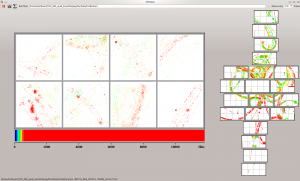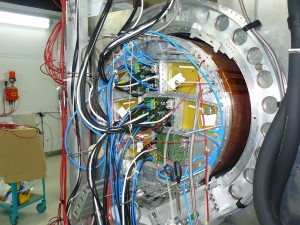The InGrid chip is an ingenious little thing. It is essentially a Timepix chip equipped with 256×256 pixels. On top of these sits a grid that features a hole over each pixel. Within the 50-µm gap, a strong electric field is generated. This means that electrons flying through one of those holes feel this field and are amplified in an avalanche – the pixels receive the signals from single particles. “It shows every single electron from the ionisation trail of the passing particle,” says Michael Lupberger from Bonn university in Germany, who recently spent time in a test beam at the German lab DESY to test the InGrid technology for the first time at a large scale. “It helps to better identify the track and the energy of the passing particle.”
InGrids are a proposed alternative to the ILD TPC’s recommended technologies of pad-based GEMs and Micromegas readout. The test beam team from Bonn and Siegen university (DE), CEA Saclay (FR) and NIKHEF (NL) used the PCMAG setup to test three modules of which one held 96, the other two 32 chips. On the central module, half of the total surface was covered by pixels. In total they ran some 160 InGrid chips, covering an area of 320 square centimetres and firing up to 10.5 million channels. The size and the density of readout channels meant that the setup with the InGrids could detect particle tracks with a length of 60 centimeters.
The InGrid chips, made at the IZM Fraunhofer Institute in Berlin out of Timepix wafers in a photolithographic process, were assembled in a Bonn cleanroom into octoboards fitting the magnet setup at DESY. After roughly a week of data taking, the team is now busy dissecting the results. “It’s already a great step forward to know that we can equip a full module, set it up, run and and collect data,” says Jochen Kaminski, also from Bonn. “We’re three modules closer to the final 448 modules for the ILD TPC.”
InGrid are also used in other experiments, for example the CAST axion experiment at CERN, and may be interesting for medical applications like proton tomography.



Recent Comments